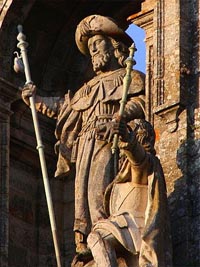From its very beginnings Christianity has used symbolism. Each saint has a story and a reason why they led an exemplary life. Symbols have been used to tell these stories throughout the history of the Church.
A number of Christian saints are traditionally represented by a symbol associated with their life, termed an attribute or emblem, in order to identify them. The study of these forms part of iconography in art history. They were particularly used so that the illiterate could recognize a scene, and to give each of the Saints something of a personality in art.
They are often carried in the hand by the Saint.
Attributes often vary with either time or geography, especially between Eastern Christianity and the West. Orthodox images more often contained inscriptions with the names of saints, so the Eastern repertoire of attributes is generally smaller than the Western. Many of the most prominent saints, like Saint Peter and Saint John the Evangelist can also be recognized by a distinctive facial type – as can Christ. In the case of later saints their actual historical appearance can also be used; Saint Bernardino of Siena (1380–1444) is one of the earliest whose distinctive appearance was well-known from early prints and is nearly always used by artists. Some attributes are general, such as the palm frond carried by martyrs.
The use of a symbol in a work of art depicting a Saint reminds people who is being shown and of their story. St. James is often depicted as an old man in pilgrim garb with a staff and a sea shell.
He traveled and spread the Word for nearly forty years in Spain.
It is said that one day, as he prayed, the Blessed Virgin Mary appeared to him and asked him to build her a church, which he did.
Later, James returned to Jerusalem but was martyred for his faith by King Herod, who decapitated him. Saint James the Greater is known as the first apostle to die.
As he was not allowed to be buried following his martyrdom, his remains were taken to Compostela, Spain, by some of his followers, who buried him.
In the ninth century his remains were discovered and moved to a tomb in Santiago de Compostela. Today, his remains can still be found in the Cathedral of Santiago.
Because Santiago de Compostela is the most frequently visited place pilgrims migrate to following Rome and Jerusalem, Pope Leo declared it a shrine.
Attributes often vary with either time or geography, especially between Eastern Christianity and the West. Orthodox images more often contained inscriptions with the names of saints, so the Eastern repertoire of attributes is generally smaller than the Western. Many of the most prominent saints, like Saint Peter and Saint John the Evangelist can also be recognized by a distinctive facial type – as can Christ. In the case of later saints their actual historical appearance can also be used; Saint Bernardino of Siena (1380–1444) is one of the earliest whose distinctive appearance was well-known from early prints and is nearly always used by artists. Some attributes are general, such as the palm frond carried by martyrs.
The use of a symbol in a work of art depicting a Saint reminds people who is being shown and of their story. St. James is often depicted as an old man in pilgrim garb with a staff and a sea shell.
He traveled and spread the Word for nearly forty years in Spain.
It is said that one day, as he prayed, the Blessed Virgin Mary appeared to him and asked him to build her a church, which he did.
Later, James returned to Jerusalem but was martyred for his faith by King Herod, who decapitated him. Saint James the Greater is known as the first apostle to die.
As he was not allowed to be buried following his martyrdom, his remains were taken to Compostela, Spain, by some of his followers, who buried him.
In the ninth century his remains were discovered and moved to a tomb in Santiago de Compostela. Today, his remains can still be found in the Cathedral of Santiago.
Because Santiago de Compostela is the most frequently visited place pilgrims migrate to following Rome and Jerusalem, Pope Leo declared it a shrine.

